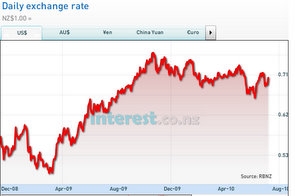
 By Mike Jones*
By Mike Jones*
The NZD opens up 1.3% this morning after an overnight session that saw risk very much back on the table.
Both the NZD and the AUD were standout performers as the USD was sold overnight against risk currencies.
We open this morning with the dollar index sitting on trendline support. With not much in the way of US data in the next couple of trading sessions, equities and labour market data out of Australia today will set the path for NZD.
In respect of the latter, the market is looking for yet another reasonable employment gain for Australia in its June figures, and for the unemployment rate to hold firm at a level the envy of the world, at 5.2%.
Overnight, the main news was that the European bank stress tests will assume a 17% haircut on Greek bonds – half the worst case scenario estimated by some US commentators.
This was associated with further recovery in European equities overnight, in the end.
Also, expectations of a stronger US consumer helped underpin views that the upcoming US reporting season will see a rise in U.S profitability. A Bloomberg survey estimated that profits for S&P 500 companies are projected to increase by 34% compared to the 27% foreseen on 29 March. The US reporting season starts next week. This could prove important in currency land, especially given the correlation between risk currencies and equities of late.
Today expect to see the NZD find support back towards the 0.6980-0.7000 window. Topside, the 0.7105 level represents a 50% retracement of the move from the October 2009 0.7640 high to the recent lows seen only two months ago. Of course, the recent highs of 0.7150 will also be a number to bear in mind.
Majors
With every single Asian stock market in the red overnight, the pro-risk mood we commented on yesterday was pretty short-lived. European equities opened around half a per cent lower which continued to weigh on USD/JPY, driving the pair to within 5 ticks of its 2010 low at 86.97.
The Japanese authorities, however, were notable only for their total silence on the matter. No veiled threats of intervention, no concerns about export competitiveness, no rumours of Central Bank ‘rate checking’ and no sign either of the alleged postal bid which can sometimes appear in periods of market stress.
Though there was much talk of large sell stops at USD/JPY86.90, the downside push lost momentum ahead of 87.00 and the rest of the session saw only light trading volume.
The euro too was initially pressured by equity weakness and not helped by a headline print of -0.5% for German factory orders, against consensus expectations of a +0.3% gain. EUR/USD fell to a post-data low of 1.2553 but this was still comfortably above the 1.2480 level from which the Single Currency has bounced twice in the last four days.
A closer reading of the data showed consumer goods orders up a punchy 3.6% m/m, with the domestic component up +3.9%. If this is indeed evidence of an increase in spending at home, then the German economy, unlike its Southern neighbours, is rebalancing impressively. By mid-afternoon, the EUR had reached a best level of USD1.2648, helped also by a sudden, but largely inexplicable, turnaround in global stock markets.
Elsewhere, although the GBP is quoted by the professional FX market in pounds per euro, the inverse exchange rate is most common amongst corporate and SME foreign exchange clients. EUR/GBP0.8333 corresponds to GBP/EUR1.20 and – as we noted in this week’s ‘Global FX Strategist’ – there is good interest from UK exporters to sell EUR receivables at this level in order to protect against a further depreciation of the euro in H2 2010 and into 2011.
Having hit an intra-day low of GBP/EUR1.1990, the pound then gained steadily throughout the afternoon to reach a high of EUR1.2044. Today’s session will be dominated not just by the protracted saga of the stress tests for European banks, but the Press Conference held by ECB President Trichet.
After his faltering and unconvincing performance in May which was followed by a complete volte-face over ECB purchases of Eurozone sovereign debt, the June event was much more assured and self-confident.
We commented on this at the time, and it is noticeable that the cycle low of EUR/USD at 1.1877 came three days prior to the June meeting. Since then, it has barely looked back and we haven’t traded below 1.20 for a single minute since that Press Conference.
* Mike Jones is part of the BNZ research team. All its research is available here.
No chart with that title exists.
`

We welcome your comments below. If you are not already registered, please register to comment.
Remember we welcome robust, respectful and insightful debate. We don't welcome abusive or defamatory comments and will de-register those repeatedly making such comments. Our current comment policy is here.